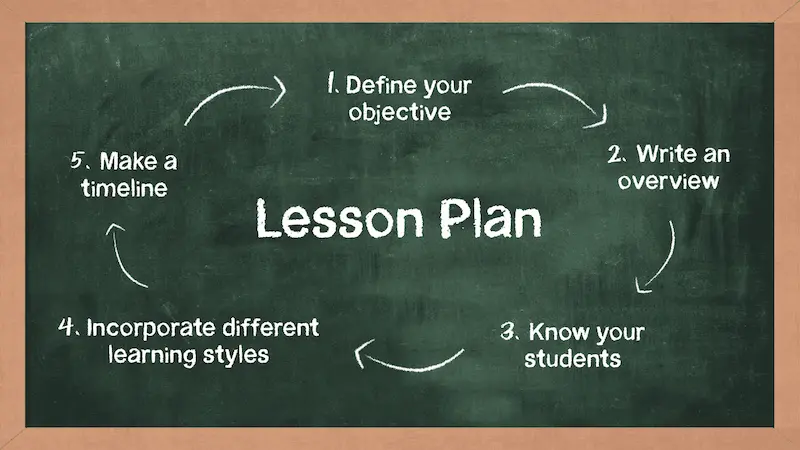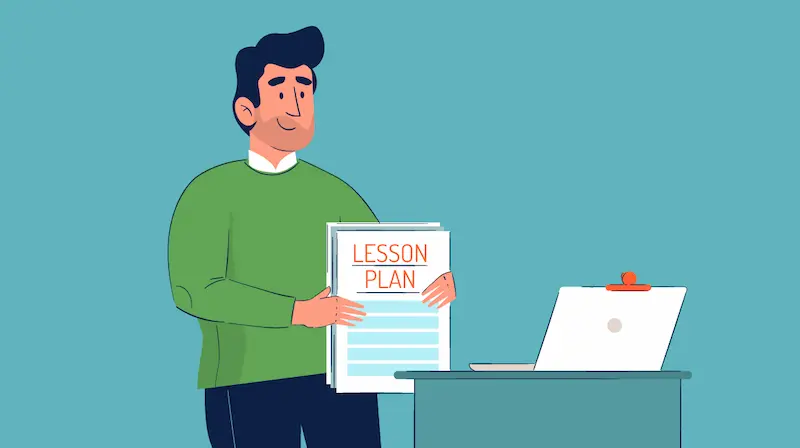Lesson planning is the cornerstone of effective teaching methodologies. Its significance lies not only in guiding educators through a structured approach but also in profoundly impacting students’ learning journeys.
A meticulously designed lesson plan aids in delivering content seamlessly while fostering engagement, comprehension, and retention among learners. It serves as a roadmap guiding teachers through instructional phases, ensuring a cohesive learning experience for students with diverse backgrounds and abilities.
Table of contents
- Defining Effective Lesson Plans
- Understanding Your Audience
- Clear Learning Objectives
- Assessment Alignment
- Engaging Activities and Resources
- Differentiation and Inclusion
- Sequencing and Structure
- Incorporating Technology
- Adaptation and Flexibility
- Multisensory Learning
- Time Management
- Formative Assessment
- Parent and Community Involvement
- Conclusion
- Frequently Asked Questions (FAQ’S)
Defining Effective Lesson Plans
An effective lesson plan transcends being a mere structured set of activities. It encapsulates clear, concise elements intricately aligned with predetermined educational objectives. This clarity empowers educators to navigate teaching with precision, ensuring each component contributes directly to intended learning outcomes. Understanding this relationship enables teachers to tailor plans effectively, catering to specific student needs and learning styles.
Understanding Your Audience
Successful lesson planning hinges on acknowledging diverse student profiles and learning needs. A holistic understanding of class demographics, individual learning strategies, cultural backgrounds, and potential challenges allows educators to create inclusive lesson plans. Adapting teaching strategies cultivates equity, fostering belonging and engagement among students.
Clear Learning Objectives
Establishing goal setting on learning forms the cornerstone of a successful lesson plan. When teachers define objectives that are both explicit and measurable, it lays a strong foundation for the entire teaching and learning experience. These objectives serve as beacons, directing both educators and students on the path to achieving desired learning outcomes. They offer a sense of direction, ensuring that everyone involved is on the same page and working towards common educational aims.
Having well-defined learning objectives brings clarity to the instructional process. They act as guideposts, helping teachers structure their lessons effectively while offering students a clear understanding of what they’re expected to learn. Furthermore, these objectives aid in maintaining focus throughout the learning journey. By articulating precisely what students are meant to achieve, teachers can tailor their teaching methods and activities accordingly, ensuring alignment with the intended learning outcomes.
Assessment Alignment
Aligning assessments with established learning objectives is crucial for accurately measuring student progress. Ensuring assessment strategies correspond directly to the intended outcomes helps educators gauge comprehension depth and identify areas requiring further attention. Integrating various assessment methods—formative assessments, summative evaluations, peer assessments, and self-assessments—provides a comprehensive overview of student learning.
Engaging Activities and Resources
Incorporating diverse activities and resources within lesson plans catalyzes heightened student interest and participation. Utilizing multimedia presentations, interactive online tools, hands-on activities, and real-world examples enriches learning experiences, catering to different learning styles and promoting deeper understanding and retention.

Differentiation and Inclusion
Creating an inclusive learning environment involves using various strategies that cater to the diverse learning needs and abilities of all students. When educators implement techniques like tiered assignments, flexible grouping, and different teaching methods, they ensure that every student can learn at a level that suits them best. Tiered assignments mean giving different tasks to students based on their skills, making sure everyone is appropriately challenged. Flexible grouping involves organizing students in different ways for learning activities, allowing them to work with various peers and learn in different settings.
Moreover, using varied teaching methods helps students engage better with the curriculum because different approaches cater to different learning styles. For instance, some students may learn better through visual aids, while others may prefer hands-on activities.
Sequencing and Structure
Logical sequencing of activities within a well-organized structure is pivotal for seamless flow and comprehension of lessons. A well-structured lesson plan guides activity progression coherently, facilitating smooth transitions between learning segments and aiding students in grasping concepts progressively.
Incorporating Technology
Integrating technology into lesson plans enhances the learning experience and equips students with essential 21st-century skills. Leveraging educational apps, interactive software, virtual simulations, and collaborative online platforms fosters innovation, engagement, and expands learning beyond traditional classroom boundaries.
Connecting lessons to real-life scenarios nurtures problem-solving skills and critical thinking skills for kids. Demonstrating practical applications of learned concepts heightens student engagement, motivation, and fosters a deeper understanding of the subject matter.
Adaptation and Flexibility
Flexibility is crucial in accommodating students’ needs and navigating unforeseen changes during lessons. Educators who can adapt teaching approaches in real-time ensure a dynamic and effective learning process. This flexibility encourages student engagement and allows personalized adjustments to meet evolving classroom needs.
Implementing diverse strategies to maintain student interest and promote active learning is vital for creating a vibrant classroom atmosphere. Techniques like group discussions, debates, hands-on experiments, and role-playing activities not only capture students’ attention but also stimulate critical thinking and collaboration among peers.
Multisensory Learning
Incorporating visual, auditory, and kinesthetic elements into lesson plans caters to diverse learning styles, enhancing comprehension and retention. Engaging multiple senses creates a more immersive learning experience, ensuring effective understanding for students with various learning preferences.
Time Management
Efficient time allocation within a lesson plan is essential for comprehensive content coverage within the allocated timeframe. Time management strategies, including setting clear time limits for activities and prioritizing essential concepts, ensure instructional goals are met without compromising depth or understanding.
Formative Assessment
Continuous assessment and feedback collection play a crucial role in guiding instructional improvements. Regular formative assessments, coupled with constructive feedback, enable educators to monitor student progress, address learning gaps, and adapt teaching methodologies for an enhanced learning experience.
Engaging in collaborative lesson planning enables educators to share insights, resources, and best practices. This collaborative approach fosters professional growth, enriches teaching methodologies, and encourages innovative approaches to lesson design and delivery.
Parent and Community Involvement
Involving parents and the community enriches the educational experience. Establishing avenues for parental engagement, community partnerships, and utilizing external resources support classroom learning and reinforce the relevance of education beyond the school environment.
Moreover, regular self-assessment and reflection on lesson delivery and outcomes pave the way for continuous improvement. Educators analyzing the effectiveness of teaching strategies and student responses can identify areas for enhancement, refining lesson plans for future implementation.
Conclusion
Effective lesson planning necessitates a comprehensive approach that encompasses understanding students’ needs, setting clear objectives, employing diverse strategies, and continual reflection and refinement. By conscientiously implementing these multifaceted strategies, educators can craft dynamic, inclusive, and effective lesson plans that foster optimal learning outcomes and empower students on their educational journey.
To get your hands on more educational and free resources on coding for kids, robotics for kids, financial education for kids, etc., do check out the BrightCHAMPS Page now!
Frequently Asked Questions (FAQ’S)
A1. To create inclusive lesson plans, start by understanding your students’ diverse learning styles, abilities, and needs. Incorporate various teaching methods like visual aids, hands-on activities, group discussions, and auditory elements. Provide multiple ways for students to demonstrate understanding and accommodate different paces of learning. Differentiate instruction by offering additional support or challenges based on individual requirements. Collaborate with special education professionals or experts to ensure your plans cater to all learners.
A2. A well-structured lesson plan typically includes clear learning objectives, an engaging introduction, a sequence of activities aligned with the objectives, guided practice opportunities, independent practice or assessment tasks, and a summarizing conclusion. It should also integrate varied instructional strategies, appropriate resources, and assessment methods to gauge student understanding.
A3. Integrating technology can enrich lesson plans by offering interactive and multimedia resources. Utilize educational apps, online simulations, digital presentations, or collaborative platforms to reinforce concepts. Tailor technology use to support diverse learning styles, allowing for personalized learning experiences. Ensure access to necessary tech tools, offer guidance on their use, and assess their effectiveness in achieving learning goals.
A4. Engage students by incorporating interactive activities, discussions, real-world examples, and relevant content. Use storytelling, gamification, or hands-on experiments to make learning enjoyable. Encourage participation through questioning, group work, and incorporating students’ interests into the lesson. Vary instructional methods, provide immediate feedback, and create a positive and inclusive classroom environment to sustain engagement.
A5. Flexibility is key when facing unexpected changes. Be prepared with alternative activities or resources that align with the lesson objectives. Adjust pacing, simplify or extend tasks based on students’ needs or time constraints. Reflect on previous lessons for adaptable elements. Embrace spontaneity while keeping the main learning goals in focus and communicate changes effectively to students to maintain clarity.


 We are an army of educators and passionate learners from BrightChamps family, committed to providing free learning resources to kids, parents & students.
We are an army of educators and passionate learners from BrightChamps family, committed to providing free learning resources to kids, parents & students.












